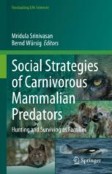Search
Search Results
-
Effects of predator novelty on intraguild predation communities with adaptive prey defense
Understanding coexistence within community modules such as intraguild predation (IGP), where an omnivore both preys on and competes with an...

-
Antipredator strategy of paralarvae of East Asian common octopus Octopus sinensis d’Orbigny, 1841: causing rejection after engulfing by a fish, and subsequent ink release for distraction during escape
AbstractAntipredator behavior of the paralarval stages of merobenthic octopuses is largely unknown. Reported here is an investigation of the...

-
Antipredator Defenses in Soft Corals of the Genus Sarcophyton (Octocorallia; Alcyoniidae) from Coastal Waters of Central Vietnam
AbstractAs sessile marine organisms, soft corals may use chemical or/and physical factors of defense against fish predators for their survival and...

-
Defense Strategies in Birds of Charadriidae Family
Defensive strategies are unique features of animals with aid of which they guard themselves against predators or any other potential risks. Birds...
-
Diving behavior in semi-aquatic Anolis lizards results in heat loss with sex-specific cooling tolerance
AbstractMales and females often differ in use of antipredator behaviors, particularly when antipredator behavior comes at the cost of missed mating...

-
Do Responses of Wild Macaca nigra to Crop Defense Resemble Responses to Predators?
Although conservation-minded researchers advocate that growers use a variety of methods to defend crops from wildlife, we know little about the...

-
Reactive response to predation risk affects foraging time of hares, yet not their phosphorus intake
Antipredator responses could affect nutrient intake, which could lead to nutritional deficits. However, little is known about the antipredator...

-
The impact of high temperatures on bird responses to alarm calls
AbstractGiven the current pace of climate change, high temperature events will become increasingly frequent in many parts of the world. Predicting...

-
To hatch and hatch not: does heterochrony in onset of vestibular mechanosensing explain species differences in escape-hatching success of Agalychnis embryos in snake attacks?
AbstractPhyllomedusid treefrogs hatch prematurely to escape egg predation, but escape success varies among species. Snake attacks elicited 55% less...

-
Defense of bombardier beetles against avian predators
Bombardier beetles (Coleoptera, Carabidae, Brachininae) possess a remarkable defense mechanism where a hot chemical spray is released from the tip of...

-
Host parent responses to heterospecific parasite nestling alarm calls are independent of past and current experience with experimental brood parasitism
Communication between parents and dependent offspring is critical not only during provisioning, but also in antipredator contexts. In altricial...

-
Developmental changes in red-eyed treefrog embryo behavior increase escape-hatching success in wasp attacks
AbstractThe arboreal embryos of red-eyed treefrogs ( Agalychnis callidryas ) hatch prematurely to escape from egg predators, and escape success...

-
The efficacy of a generalized antipredator defense against a novel predator depends on the source of induction in prey
Ecological naiveté or the failure to recognize a novel enemy is often put forward as a cause of extirpation of biodiversity in newly invaded systems....

-
Social Strategies of a Consummate Marine Predator: Mammal-Hunting Killer Whales
Wolves of the Sea is a commonly used moniker for mammal-hunting killer whales, but they are more than that with unique and blended characteristics of...
-
Antipredator mechanisms of post-metamorphic anurans: a global database and classification system
AbstractA crucial step in any ethological study is to distinguish and classify the observed behavior into categories. The literature on anuran...

-
Defensive alkaloid variation and palatability in sympatric poison frogs
Chemical defense in poison frogs derives from lipophilic alkaloids sequestered from dietary arthropods. Alkaloid composition varies extensively among...

-
Hypoxia constrains behavioral responses to chemical alarm cues by fathead minnows Pimephales promelas
Hypoxia is a seasonally recurring environmental condition in small temperate lakes during summer thermal stratification and under ice cover in...

-
Local adaptation of antipredator behaviors in populations of a temperate reef fish
The temperament of animals can vary among individuals and among populations, but it is often unclear whether spatial variation in temperament is the...

-
DO Toxic Invasive Prey Become a Toxin Source for Native Consumers?
Toxic organisms can become food that potentially harms consumers. When these organisms become invasive species, the harm often turns to a serious...

